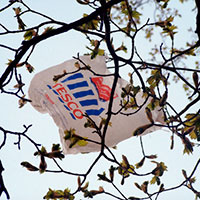 My younger daughter works as a sustainability analyst for brewers Molson Coors and she covers a great many environmental issues in her work. She recently told me that the Enviroment Agency has published a research report into the impact of ‘environmentally friendly’ shopping bags.
My younger daughter works as a sustainability analyst for brewers Molson Coors and she covers a great many environmental issues in her work. She recently told me that the Enviroment Agency has published a research report into the impact of ‘environmentally friendly’ shopping bags.
What this reveals is that the carrier bag issue is not as simple as it would seem. There is more to this than just ‘single use bad, bag for life good’. It seems to be down to the resources used, where they are made and – for natural products like cotton and paper – the high levels of inputs required to grow and process the raw materials.
This chart from the report shows the number of times the various types of bags need to be used to be a more favourable solution to the ordinary single-use high-density polythene (HDPE) bags.
Impact of HDPE bags when compared to “sustainable” alternatives
| Type of carrier | HDPE bag (No secondary reuse) | HDPE bag reused as bin liners | HDPE bag (used 3 times) |
|---|---|---|---|
| Paper bag | 3 | 7 | 9 |
| LDPE bag | 4 | 9 | 12 |
| Non-woven PP bag | 11 | 26 | 33 |
| Cotton bag | 131 | 327 | 393 |
The amount of primary use required to take reusable bags below the global warming potential of HDPE bags with and without secondary reuse
The science up to now has not been clear enough for me to stop using the single use bags, but this report certainly helps. Knowing for instance that the single use bags our customers take away are often used as bin liners adds to the confidence that we have in continuing to provide them. We also offer the ‘Bag for Life’ style that a minority of customers have taken up. We previously sold hemp carriers for a while, but no longer do so.
I think that the biggest surprise from this research is that the carriers made from cotton are potentially the least environmentally friendly in terms of Global Warming impact. The chart shows that if the ‘single use’ bags find three uses the cotton bags need to be use nearly 400 times before they match the ‘friendliness’ of the plastic variety.
The two key statements from the reports executive summary are:
Whatever type of bag is used, the key to reducing the impacts is to reuse it as many times as possible and where reuse for shopping is not practicable, other reuse, e.g. to replace bin liners, is beneficial.
The reuse of conventional HDPE and other lightweight carrier bags for shopping and/or as bin-liners is pivotal to their environmental performance and reuse as bin liners produces greater benefits than recycling bags.
So with this in mind should these HDPE bags have a message printed on them to that effect?
This Environment Agency report has been long in preparation – it was commissioned in 2005 – but it does provide a sound basis on how to proceed with the carrier bag issue. Like many sustainability issues the answer isn’t clear-cut and is down to how we as consumers use a product as well as how it has been made.





Comments
This article doesn't have any comments yet, be the first!